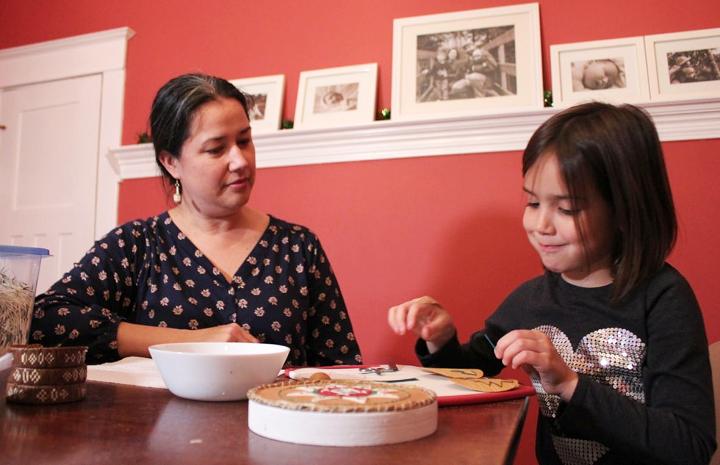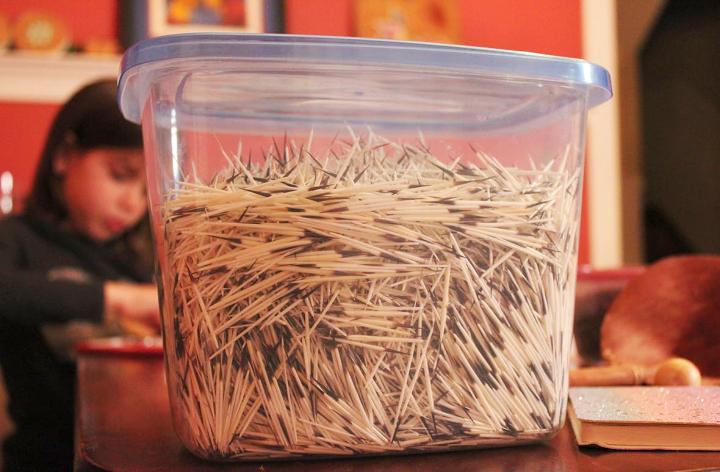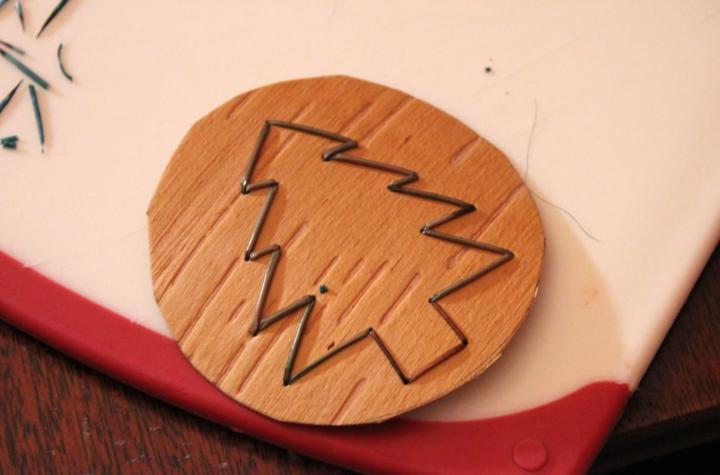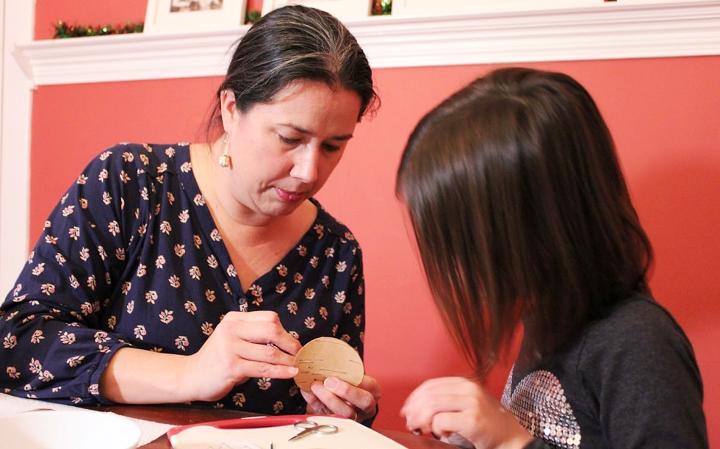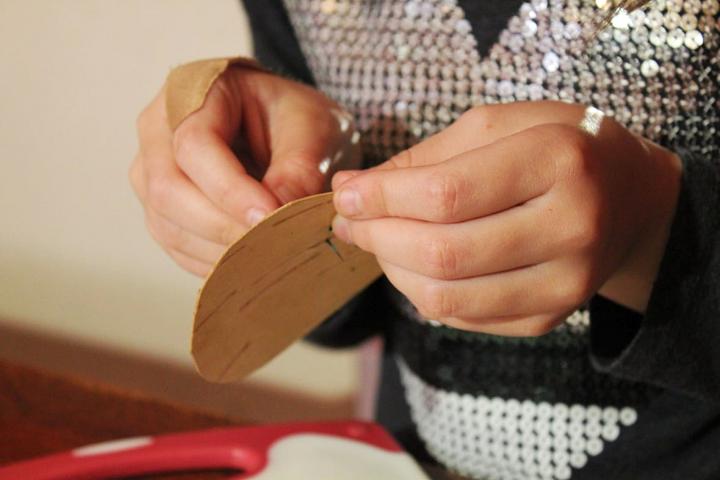 |
Canku Ota
|
 |
|
(Many Paths)
|
||
|
An Online Newsletter
Celebrating Native America
|
||
|
February 2021 - Volume
19 Number 2
|
||
|
|
||
|
7-Year-Old Teaches
Mi'kmaw Quillwork, A Skill She Learned From Her Mom
|
||
|
by Emma Smith ·
CBC News
|
||
|
Carolyn Simon
recently gave a tutorial to her Grade 2 class in Dartmouth
Head bent toward her work, Carolyn Simon uses tweezers to carefully pull a porcupine quill through a tiny hole in a piece of birch bark. She folds the quill with her fingers and then guides it through another hole, cutting the pointy end so it's flush with the bark. It's a technique she's seen her mom do hundreds of times, and while she's only seven years old, she's close to mastering it herself. "It's really cool how you can use porcupine quills from the actual animal and put them into a bark piece like this, and make like one of these designs," she said, holding up a Christmas tree ornament she's making. Carolyn is learning porcupine quillwork from her mom, Cheryl Simon, a Mi'kmaw quill artist from Abegweit First Nation on P.E.I. who now lives in Dartmouth.
Imbued in the mother-daughter lessons are conversations about science, history and tradition. "Anybody can put a quill into a piece of bark but in order to be a quiller, you have to understand cycles of grasses and trees and animals," Cheryl said. "You have to know the history of it, the design component of it, and all of that science that goes into it so that takes years of knowledge and teaching and learning and respect." Cheryl usually visits classrooms to teach students about Mi'kmaw art and culture. She couldn't do that this year due to COVID-19, so Carolyn stepped in and taught her own lesson to her Grade 2 class at Hawthorn Elementary School this fall. "Because they weren't Mi'kmaw doesn't mean they can't learn what we did before because some people don't believe Mi'kmaw people do what they used to do like a thousand years ago," said Carolyn. "I thought it would be cool for them to learn that we still do it after like a thousand years."
Mi'kmaw artists have long used porcupine quills to make designs for containers, clothing or sheaths for knives. The technique hasn't changed in generations, but each artist brings their own flourish, said Cheryl. Mi'kmaw designs are known for their vibrant colours and intricate patterns. "A lot of Mi'kmaw art had really been devalued. People were not treating it as fine art. I don't think there was a respect for the technique, the skill or the history of it," Cheryl said. "So, these days, it's really starting to come into its own again." Learning the technique Artists begin with a piece of birch bark and a stack of porcupine quills. Cheryl often gathers quills from animals that have ended up as roadkill. Another way to collect porcupine quills is to simply throw a blanket over the animal, she said. When you take the blanket off, the porcupine waddles away, unharmed, and its needles are stuck to the fabric. The quills are washed several times and then often dyed using Kool-Aid or natural dyes like beets. After that, the quills are placed in water until they become pliable and can be threaded through holes in the bark. The holes are created using an awl. It's a tool Carolyn has learned to handle with care just as she does the quills themselves. The pieces of porcupine quill that aren't used are dutifully put in a pile so that her two cats don't accidentally step on one. "If they have fur, we can't see … where the hole is in them that got poked," she said. "The black end [of the quill] is not good for you to touch because if it's not soaked and you touch that end you're going to get hurt."
After Carolyn's lesson with her class, Cheryl said the Mi'kmaw Native Friendship Centre reached out to see if she could do a lesson at the centre as well. "I think within the first three or four quills that she put in the bark, she picked up the technique, and I was really impressed with that," said Cheryl. "My mother and my aunts, my cousin and everybody who saw her do it and realized how quickly and how much she liked it, we were just all so proud." Quillwork is a simple technique but it requires a steady hand, patience and lots of practice.
If the quill hasn't been soaked in water for long enough, it will snap and if the quill pierces another quill on its way through the hole, you have to pull it out and try again. Cheryl's great-great-grandmother from Sipekne'katik First Nation was a renowned quill artist and Cheryl said she's been enamoured of the art form since she was a little girl. She remembers her mom letting her skip school, something that didn't happen often, when her aunts visited so she could learn quillwork and beadwork from them. "I didn't learn anything really about Indigenous culture when I was growing up. All of my lessons took place outside of the classroom," she told CBC's Information Morning during a recent interview.
When the Nova Scotia government began rolling out treaty education curriculum in schools, Cheryl saw an opportunity for a new generation to learn about Mi'kmaw traditions and values inside the classroom. She started visiting her son Declan's school when he was in primary. Quillwork, Cheryl said, is a great way to share Mi'kmaw culture because it encompasses so many lessons in one — from how to ecologically harvest birch bark to the math behind the intricate geometric designs. "I really want people to value Mi'kmaw knowledge," Cheryl said, "whether it's a piece of artwork that is reflective of our cultural views or even just understanding the type of environmental protections that are required to make sure that we have healthy trees." |
||||||||||||
|
|
|
|
||
|
|
||
| Canku Ota is a free Newsletter celebrating Native America, its traditions and accomplishments . We do not provide subscriber or visitor names to anyone. Some articles presented in Canku Ota may contain copyright material. We have received appropriate permissions for republishing any articles. Material appearing here is distributed without profit or monetary gain to those who have expressed an interest. This is in accordance with Title 17 U.S.C. Section 107. | ||
|
Canku Ota is a copyright ©
2000 - 2021 of Vicki Williams Barry and Paul Barry.
|
||
 |
 |
|
|
The "Canku
Ota - A Newsletter Celebrating Native America" web site and
its design is the
|
||
|
Copyright ©
1999 - 2021 of Paul C. Barry.
|
||
|
All Rights Reserved.
|
||
